Allgemeine SS M33 Early Pre-RZM Mark Service Dagger (by Robert Klaas)
CATEGORY: Version
SKU: 50.GOR.02.04.01.01.01.001.004
Estimated market value:
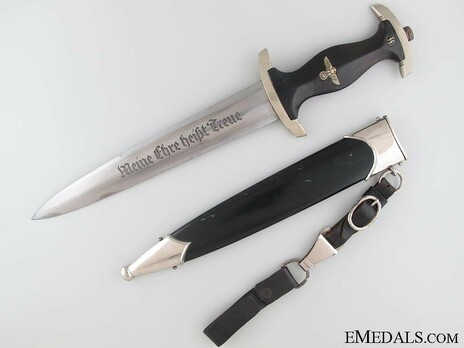
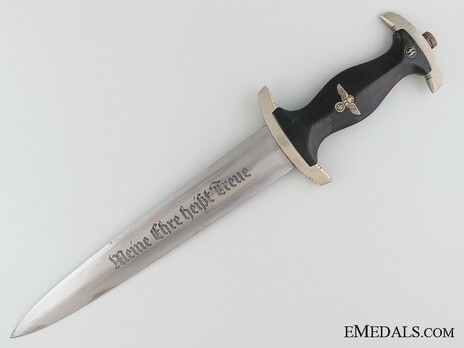
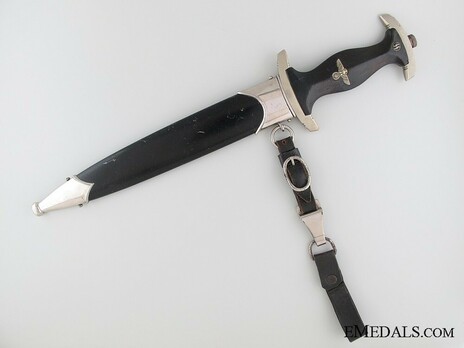
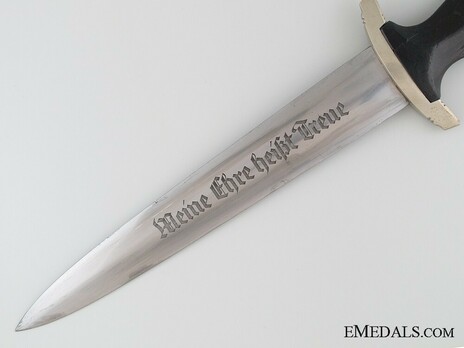
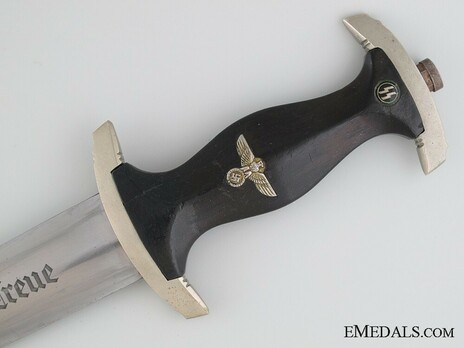
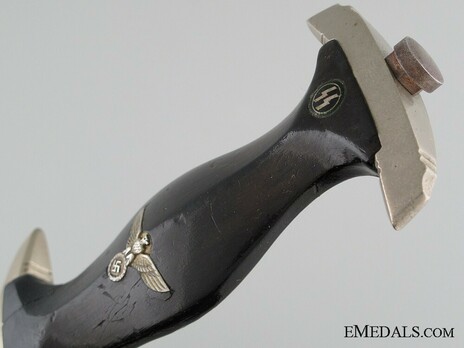

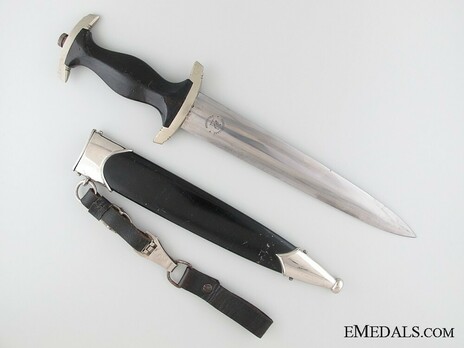
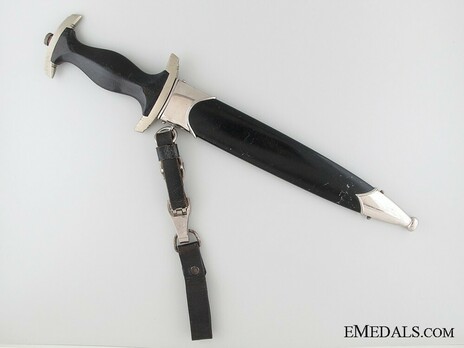
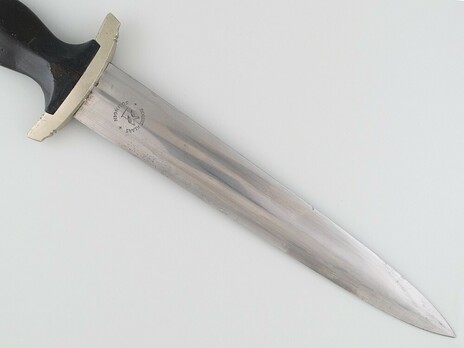
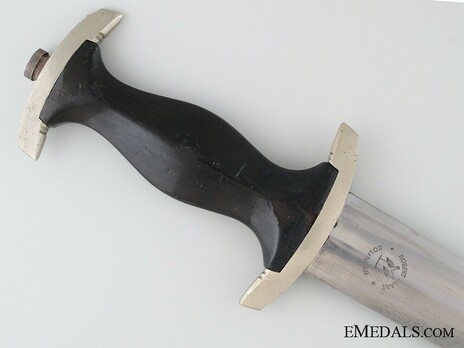
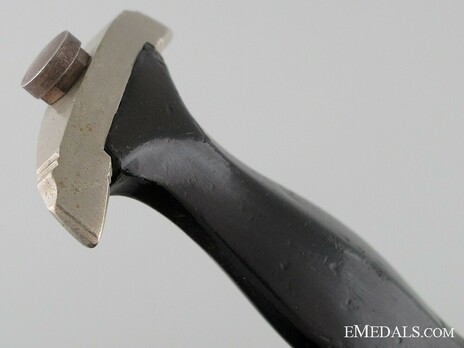
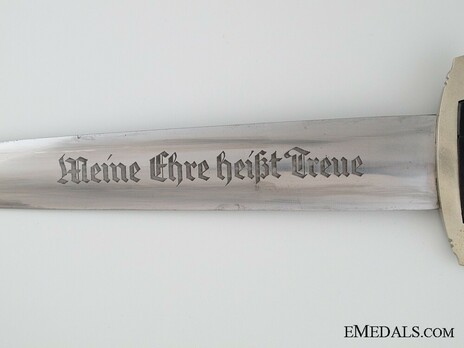
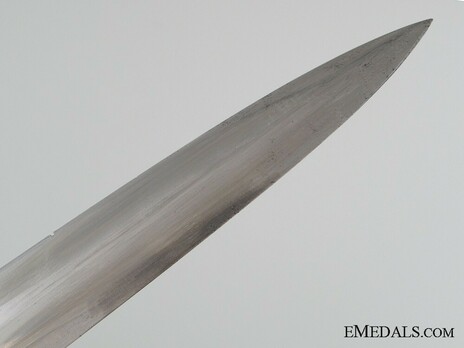
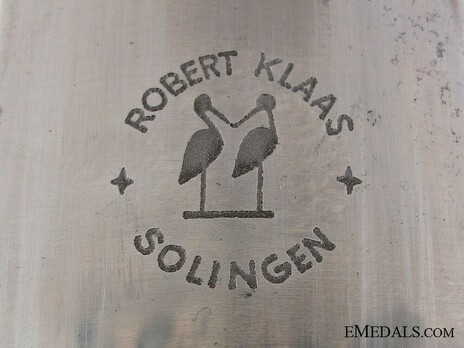
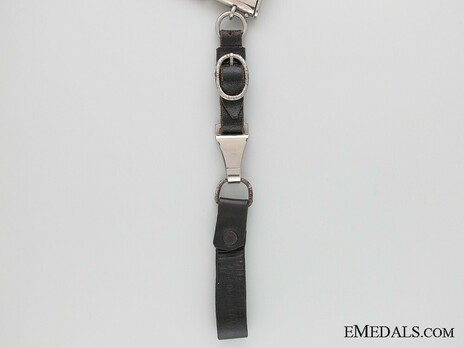
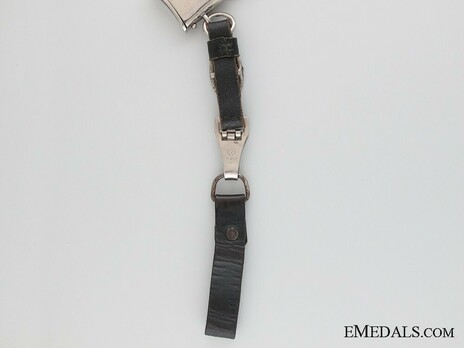
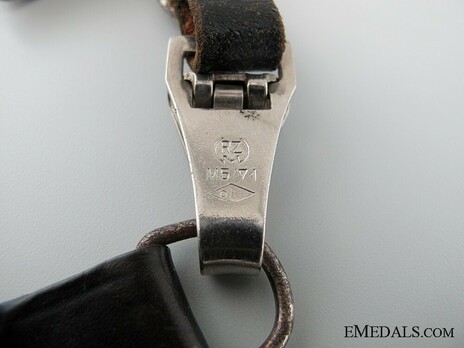
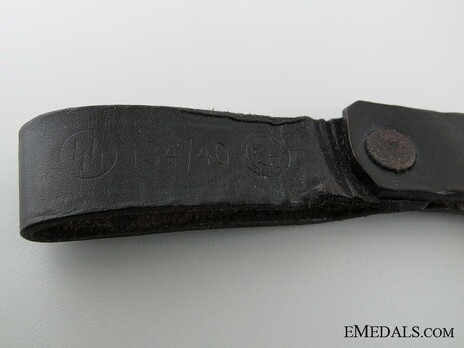
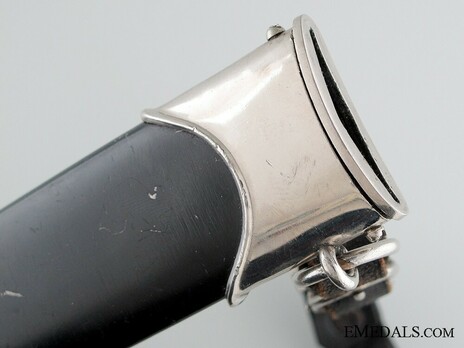
Estimated market value:
An SS Dagger by Robert Klaas - Measuring 373 mm in length with the scabbard on, this SS Dagger is engraved "Meine Ehre heißt Treue" on the blade, maker marked "ROBERT KLAAS SOLINGEN" with the company's dual stork insignia in the centre on the reverse ricasso. The blade has beautiful crossgraining, exhibiting the usual in and out runner marks, with semi-sharp edges and a semi-sharp tip, exhibiting surface wear, nick in the blade on one edge, the blade measuring 221 mm in length and rating near very fine. Nickel plated fittings on both crossguards, exhibiting surface wear. Ebony-coloured wooden handle has been lacquered, with multiple contact marks on both sides and chipping on the reverse side beside the lower crossguard. Embedded aluminum eagle shows nice detail and rates very fine. The SS insignia exhibits light contact and wear, pommel remains tight, with the dagger measuring 347 mm in length. The nickel-plated scabbard fittings exhibit light contact marks, the locket held in place via two screws, chape with ball finial, exhibiting marks and black paint loss on the body, ring with adjustable length strap attached, nickel plated clip is marked with the RZM insignia, maker marked "M5/71" with the "OLC" insignia (Overhoff & Cie Ludenscheid), belt loop strap attached to the clip via a D-ring and marked with the SS rune, the RZM insignia and maker marked "134/40", the scabbard measuring 256 mm in length. Extremely fine.
Introduction
The first model of the SS Service Dagger was designed and approved alongside the very similar SA dagger in the second half of 1933. However, it first became available for purchase in early 1934. The official order that introduced both the SS and SA daggers was signed on December 15, 1933.
The right to wear an SS dagger was granted upon induction into the SS.
The dagger was worn by Officers, Non-Commissioned Officers (NCOs) and Enlisted Men (EMs) alike in both the Allgemeine SS and later the Waffen-SS.
Officers had to purchase theirs. If they were financially unable to do so, they were given a loan, which would then be paid back in instalments. If NCOs and EMs had the financial means, they were allowed to purchase their own dagger. If not, however, SS units kept a small contingent of daggers for this scenario. These daggers were borrowed by those men who couldn’t afford a dagger of their own and had to be returned eventually.
Daggers could not be purchased in regular retail stores, but had to be ordered through official channels that were controlled by the RZM (Reichszeugmeisterei = national quartermaster’s office).
Some daggers are personalised. An example would be the stamping of the wearer’s SS identification number somewhere on the dagger, often the crossguard. Some daggers were dedicated by a friend or the men of a commander’s unit. Some have other interesting markings, for example the names of the SS Sports School Fürth or the SS Junker (officer candidate) Schools Bad Tölz and Braunschweig.
On incredibly rare occasions, personalised daggers (that are not Damascus-Bladed Honour Daggers) will feature a Damascus-style weld patterned blade.
Appearance
The upper and lower crossguard used on the hilt of early M33 daggers were cast. The same is true for the tang nut. They were made of what is known as nickel-silver, German silver, or alpaca, which is an alloy that actually doesn’t contain any silver at all, but copper, nickel, and zinc.
Some crossguards received a chrome finish. By 1936, to accommodate the need to supply a growing SS force, some methods to cut cost and labour were introduced, resulting in overall lower quality production. Crossguards were now often made via injection molding, using light weight pot metal, zinc, or aluminum, sometimes lightly nickel-plated to appear to have been made of superior materials.
The reverse of the lower crossguard may carry a Roman numeral, either I, II, or III, which may identify a distribution area. I is the most common, followed by III, while II is quite rare.
They may have been applied by the RZM. Some crossguards are stamped with Arabic numerals, but their purpose is unknown (except on dedicated daggers, see specific products for more information).
Another part of the dagger that was made of nickel-silver is the scabbard fittings, being stamped from metal sheets. Some scabbard fittings received a chrome finish. Later scabbard fittings were made of just nickel to keep production costs lower.
The scabbard’s throat contains an inner sleeve to retain the spring scabbard liner/runners. Early sleeves were made of nickel-silver, while later ones were made of steel. Early runners were made of brass, while later runners were often made of aluminum.
The scabbards were made of different materials, usually steel, however, some very early examples were made of brass.
Early scabbards were chemically blued and then lacquered to achieve their colour. However, this process was time-consuming, so later scabbards were instead spray-painted black. The blued scabbards also did not hold their finish very well even during the short period of the Third Reich, and so today they are often found with partial loss of their colour. Some were painted over in black in the 1930s or 40s. Intact blued scabbards are rarely found today.
Some companies used up stocks of blued scabbards well into the late 1930s, so that late M33 daggers, as well as M36 daggers, can sometimes be found with them.
The grip is made from wood that has been dyed black. The obverse contains a button featuring the SS runes at the top and a national eagle emblem with a swastika in the centre.
The blade is forged from steel. Very high quality materials were used with the earliest daggers, but progressively the quality declined. All SS daggers have the organisation’s motto, “Meine Ehre heißt Treue” (my honour is loyalty) in Gothic letters acid-etched onto the obverse blade. A somewhat rare variation is an additional exclamation mark after the motto. The maker’s mark and RZM code on the reverse of the blade were applied in the same way.
Makers
Almost all companies producing SS daggers were situated in the city of Solingen, where traditionally all sorts of knives and blades were manufactured. Solingen has therefore been nicknamed the “city of blades”.
Early daggers feature the manufacturing company’s logo as a maker mark on the reverse blade, just under the cross guard. At some point, the RZM introduced individual codes for each company to use instead of their maker marks. Initially after this change, some companies would double mark their daggers with the RZM code and their company logo, but this practice was forbidden at some point and didn’t occur anymore, certainly not after 1940.
While there are some exceptions to this rule, in general an RZM code would be of the following pattern: RZM logo - 1164/38 SS, with the number part differing for each manufacturer and the two digits after the stroke standing for the year of production. Since an official period list of all codes has not been found, the holders of several codes are still unknown. A list of known manufacturers’ codes can be found in Thomas T. Wittmann’s “Exploring the Dress Daggers and Swords of the German SS”, page 162.
Most early M33 daggers available today were produced by the following makers: Carl Eickhorn; Richard Abraham Herder; Heinrich Böker; Robert Klaas.
Less common are: Gottlieb Hammesfahr; Ernst Pack & Söhne; Carl Bertram Reinhard & Sohn; as well as these yet to be identified makers that are only known by their RZM codes: RZM 120/34 SS; RZM 121/23 SS; SS 188/35 RZM.
Producers that are rarely encountered today are: Artur Schüttelhöfer (ASSO); Jacobs & Co.; Eduard Gembruch; Friedrich Herder A. S.
Extremely rare are daggers by: Weyersberg, Kirschbaum & Cie. (WKC); F. W. Backhaus; Lauterjung & Sohn (Puma); Carl Julius Krebs; Wilhelm Kober (situated in Suhl); Klittermann & Moog; Louis Perlmann (Louper).
This list of makers is not a definitive one and may be added to in the future.

Comments
Sign in to comment and reply.


Scroll Top